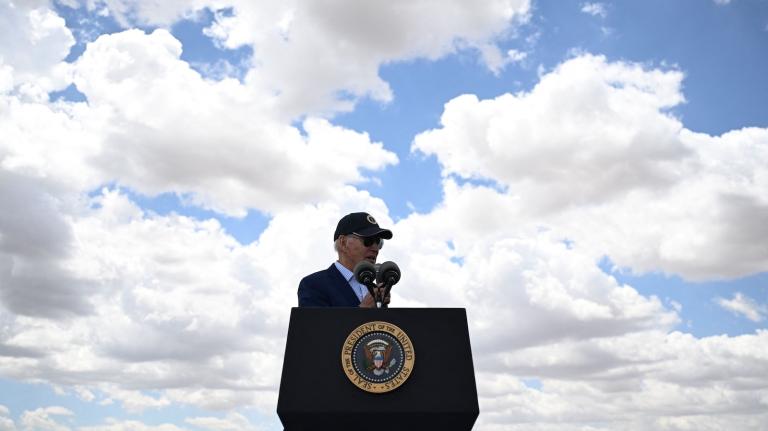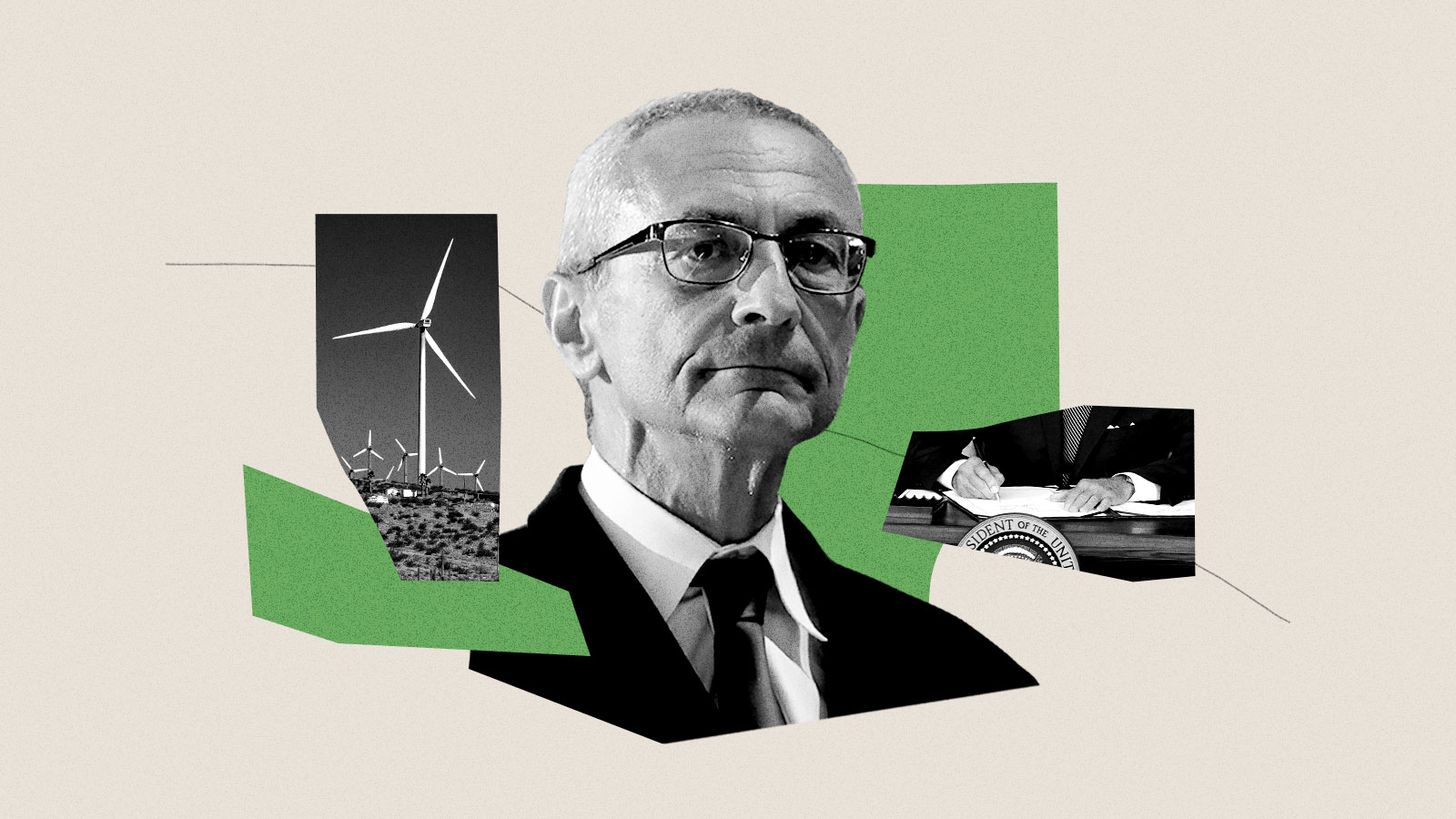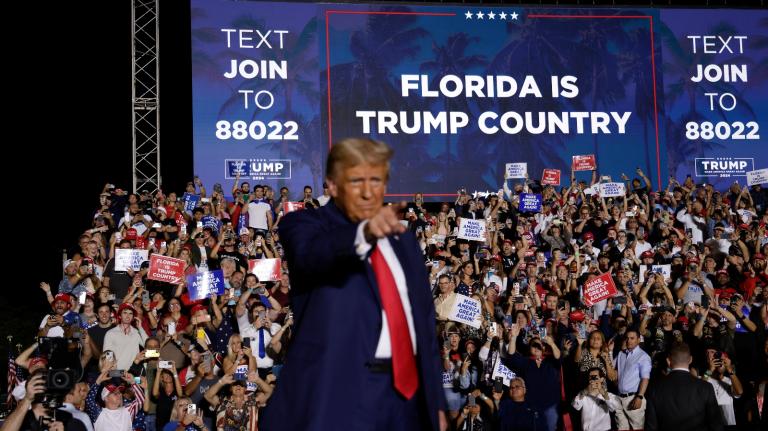One year ago, President Joe Biden inked the largest investment in fighting climate change in United States history. That law, called the Inflation Reduction Act of 2022, or IRA, funnels hundreds of billions of dollars into clean-energy tax credits for power producers, rebates for electric vehicles and heat pumps, and other emissions-fighting measures. After decades of inaction on climate change, the IRA marked a new era in the nation’s belated quest to ratchet down greenhouse gas emissions.
But the fight over the law isn’t over yet. Recent polling shows that a whopping 7 in 10 Americans say they haven’t heard anything substantial about the IRA, an apparent indication that most voters aren’t thinking about it as the 2024 presidential election approaches. Furthermore, even though most new investment from the bill has flowed to red states, many Republican leaders are pushing back against it.
It’s also far from guaranteed that the law will work as planned. The bill consists of more than a hundred different provisions, many of them involving complicated changes to the tax code, and some of those provisions are already hitting snags. Even if everything goes exactly right, experts believe the bill will still leave the U.S. short of President Biden’s stated climate goals. In all likelihood, the U.S. will need to pass more climate legislation to achieve those goals. The public’s appetite for that will hinge on the success of the IRA.
The man tasked with ensuring the bill’s success is John Podesta, a veteran political strategist who served as a senior White House official under Bill Clinton and Barack Obama but became something close to a household name only after then-presidential candidate Hillary Clinton’s emails were leaked. Podesta is fond of saying that he “failed at retirement” — he thought he was done with politics for good when Biden tapped him to shepherd the rollout of his landmark legislative achievement.
“I was ready to ride off into the sunset,” Podesta told Grist. “But then the president asked me to come back.”
Now Podesta spends his days pitching the IRA to the companies and elected officials whose buy-in will determine its success; he also supervises a suite of Cabinet agencies as they work out the kinks in the law. In an interview conducted just before the one-year anniversary of the bill, Podesta spoke with Grist about why he thinks the law will come to be as durable as the Affordable Care Act, how the administration is pushing green technology manufacturers toward “labor neutrality,” and why he thinks you should tell your neighbors about IRA benefits.
This interview has been condensed and edited for clarity.
Q. You’re in charge of implementing the IRA. A lot of our readers might want to know: What do you do all day?
A. Look, this is a multifaceted bill. There’s 135 separate programs in the bill. A good deal of the work is being done through the tax code. So I spent a lot of time working with the Department of Treasury, the Department of Energy, and other related agencies — like the Labor Department on some of the provisions — just trying to get guidance out so that the private sector has clarity about how it can take advantage of the support for clean energy and clean technology that’s in the bill.
One of the interesting elements of the bill was: it’s just not a power-sector-only bill. It attacks all the emitting sectors: power, transportation, buildings, forestry and agriculture, as well as manufacturing and infrastructure. So given the sweep of that, there’s a lot of detail that needs to be worked out. And in addition to talking to a lot of companies who are trying to plan for the future and raising issues about how to interpret various provisions of the bill, I spent a lot of time talking to my colleagues in other federal agencies to make sure that we get clarity. And then there’s $100 billion worth of grants that we’re working to move quickly and expeditiously. The money is available for some period of time, but we want to get it moving upfront because the need is so great.
Q. A recent Washington Post poll found that 7 in 10 Americans don’t know very much about the IRA at all. What does it tell you about the bill? Are there efforts underway to mitigate that?
A. It’s really natural in today’s political environment that people don’t pay attention to legislation, particularly when you’re talking about specific legislative names. They don’t really relate to it on that basis. But they do relate to projects, jobs, companies coming into their communities, and I think the general level of public support remains high across the political spectrum.
I’m a veteran of the Affordable Care Act, and the difference between the ACA and the clean energy investments in the IRA is that the Affordable Care Act, by the time it actually passed, was kind of unpopular. It took a while for people to feel the benefits of it. Now, notwithstanding Republican efforts, they can’t tear it away, because people are really seeing its benefits. I think the same thing will be true of the Inflation Reduction Act. Whether people relate to the name of the bill or not, you know, that’s for others to judge.
Q. You mention there’s a lot of corporate investment happening right now, like big manufacturing investments in electric vehicles, and it’s true that Americans will notice if there’s a new factory in their town. But the consumer-facing side of the bill does rely on people knowing they can claim a tax credit for a home retrofit or a heat pump. Are you concerned that the lack of awareness is going to hinder the uptake of those consumer credits?
A. I think we’re working hard to make sure it doesn’t, and we need consumer-facing businesses to help people know what they can take advantage of. The Department of Energy, for instance, has made a series of grants to upgrade the training of people who are in the HVAC business, so that they know the benefits that are available to consumers. You mention heat pumps — generally those are point-of-failure purchases, so you’ve got to know about the availability. It’s a little easier on the auto side, because the auto companies are all over this movement toward electrification: They’re advertising heavily on it, they’ve committed very substantial capital to it. It’s important for us, as the government, to be out there talking about the benefits, but some of this is neighbor to neighbor.
Q. Four Republican states have said that they won’t take IRA money, even though most of the benefits of this bill are actually going to red states. Does that hold up the implementation? How much does that make your job harder?
A. I mean, it’s an unusual decision to refuse to support at a time when virtually every part of the country is feeling some kind of extreme weather. You don’t have to go to the deadliest fire in the last hundred years of American history, in Maui. It was over 110 degrees for 31 straight days in Phoenix. The floods in upstate New York, in Vermont, and the extreme heat in the south and the Southeast. So, you know, putting your head in the sand and ignoring the reality, and ignoring the science, and ignoring everybody’s lived experience to make a statement that everything has to be a culture war issue, is sort of unusual.
Four [states] turned down the planning money, but 46 states, the District of Columbia, and Puerto Rico took it. So I feel like we’re moving forward. I spend time talking to Republican governors, and unlike their counterparts in the House of Representatives, they’re anxious to attract the investment. I saw Governor [Kevin] Stitt from Oklahoma, and he just landed a big solar plant in Oklahoma. And all he wanted to talk about is why the Volkswagen Battery plant got away from him and what more he could do to attract more clean investment.
Q. You’re drawing a distinction between Republican governors, who obviously want to land these investments, and the House GOP — many members of which have said that they want to repeal the IRA. What happens if come 2025, the credits are rescinded or limited? How damaging do you think that would be for the decarbonization process in the U.S.?
A. This is the most significant piece of our ability to hit the pledge that President Biden made in 2021 to cut our greenhouse gas emissions between 50 and 52 percent by 2030. Around 40 to 42 percent of that is a result of the Inflation Reduction Act, and that depends on tax credits being available through the rest of this decade. House Republicans have tried on several occasions to repeal large parts of it, but I think the more people see and feel the benefits, the harder and harder that will be. These companies are investing [in renewable energy] because the structure of this law gives them certainty. Rather than the on-off, on-off [structure] of previous renewable credits, they have ten years of certainty. I think those investments will prove to be durable, and I don’t know that Republicans, even if they had more power, would walk away from that.
Q. A lot of the investments that you’re talking about so far have gone to red states. In particular, a lot have gone to right-to-work states and states with lower prevailing wages. Is that outcome problematic for an administration that has prioritized union jobs?
A. Because [the legislation is] built into the tax code, companies are going to make individual choices. I think what we expect from them is to give everywhere a fair shot, and we want to push them towards labor neutrality. We saw a bit of success in the Blue Bird [electric school bus factory] being organized in Georgia. There’ll be places where people want to take advantage of whatever state is offering tax breaks or lower personnel costs. But I think for the most part, we’re seeing investment all over. And obviously our voice is critical, and we’re trying to make sure that it’s loud and in support of the right to organize.
Q. We have to ask you about permitting reform, just because it seems like so much of this really hinges on that. Recent negotiations around permitting reform have sputtered out, and permitting reform has become one of those things that keeps coming back and keeps dying. Is that absolutely essential to the longevity of the IRA?
A. Cutting the time to permit and fixing the interconnection queue problems is absolutely essential. It would be great if we get some legislative support for that. But I think we’re doing everything we can to make sure these projects are indeed considered and permitted, and that any real concerns — whether those are environmental justice or environmental concerns — are considered early at the front end so that we can mitigate those concerns and move projects forward.
This is my third White House, and my fourth presidential administration, and we’re doing something I’ve never seen before, which is Cabinet-level, White House-coordinated attention to permitting at a policy level and at an individual project level. We meet regularly at a Cabinet level to try to consider both: Are there things we can do to cut time and ensure quality in the permitting process at a policy level? And then going directly to the individual projects and saying: Why are they hung up? Can we find a way to fix that?
I think when you have political accountability, starting from the [resident, saying, “I want this done,” things will happen. And I think they are happening. But could we use a lot from our friends on Capitol Hill? Yes, we could.
Q. I’m sure you know that local governments, especially in the Midwest, are putting up pretty significant opposition to the siting of wind and solar facilities. There’s one report that found 228 new laws in 35 states that make it more difficult to build these projects. To what extent do you think the local opposition represents a challenge to the rollout of the IRA? And can you even do anything about that at the federal level to make it easier to site these facilities?
A. I think that we have a role in establishing the benefits of clean power: the economic benefits, the health benefits. But I think at the end of the day, some of those decisions are localized. There’s a significant amount of money being spent to slow the buildout, that’s coming from a variety of sources and people who oppose taking action to deal with climate change. We can’t directly get involved, but we can encourage other voices to be involved in those local fights. This is going to be a little bit of hand-to-hand combat in the near term. People [from local political organizations] will come to us and say, “can’t you make [decarbonization] go faster?” And I think it’s a fair point for us to say, “You know, you have local members. What are you doing about this?”
Q. There’s been a lot of debate over a lot of the provisions in the bill, including green hydrogen, carbon capture, and biogas, with many environmental justice advocates raising concerns about them. I just wonder how you think about balancing a strong momentum for decarbonization with the concerns of the communities that are going to be near this infrastructure.
A. In our view, it’s going to be essential that we find a pathway for truly green hydrogen, because it’s going to be a very important element of decarbonizing the industrial sector. It’s also critical in terms of both air and marine fuels. But I think we also have to listen to the communities that are voicing concerns about it. There’s also going to have to be a significant amount of carbon removal in order to hit the net-zero goals by mid-century, and some of that’s going to happen by direct removal of carbon from the atmosphere. I think that it’s incumbent in this decade that we begin to create strong environmental protections for the technologies that are going to be required if we’re going to stabilize the atmosphere. We’re trying our best to make sure we’re listening to people and that we make good decisions.
Q. A lot of the consumer-focused energy efficiency programs, plus the heat pumps and solar panels, require pretty significant upfront investment. Are you concerned that the takeup will lag behind in low-income communities? Even though you get a tax credit, it’s still going to be out of reach for a lot of people.
A. We’re trying to solve for that, particularly on the rebate side. If you’re a low-income household you can switch out to a heat pump for a very, very low cost — in some cases free — but that has to be done at the point of sale, and we need to work with states to implement the credits so that there isn’t a big upfront capital expenditure. It’s a little bit different in terms of taking advantage of the tax rebate advantages, where you get that money back on your tax return, but we’re trying as much as we can to make that consumer-friendly, including working with the auto companies and dealers.
Q. It sounds like you’re kind of saying that, in addition to state and local governments, you guys need help from like, Lowe’s, or something, to make this bill work.
A. I think that’s where people get a lot of their information from, particularly in the home retrofitting area, as it relates to insulation for windows and doors and induction stoves. Those credits are generous, but people have to know about them. And so we’re trying to work with individuals in the install community and with home improvement people to do that.
Q. On the home improvement front, have you personally benefited from any of the provisions in the IRA?
A. Well, I could have, but I did it earlier. I was an early adopter of solar. I haven’t replaced my furnace yet, but when I do, I’ll get a heat pump.
Tik Root contributed reporting to this story.



